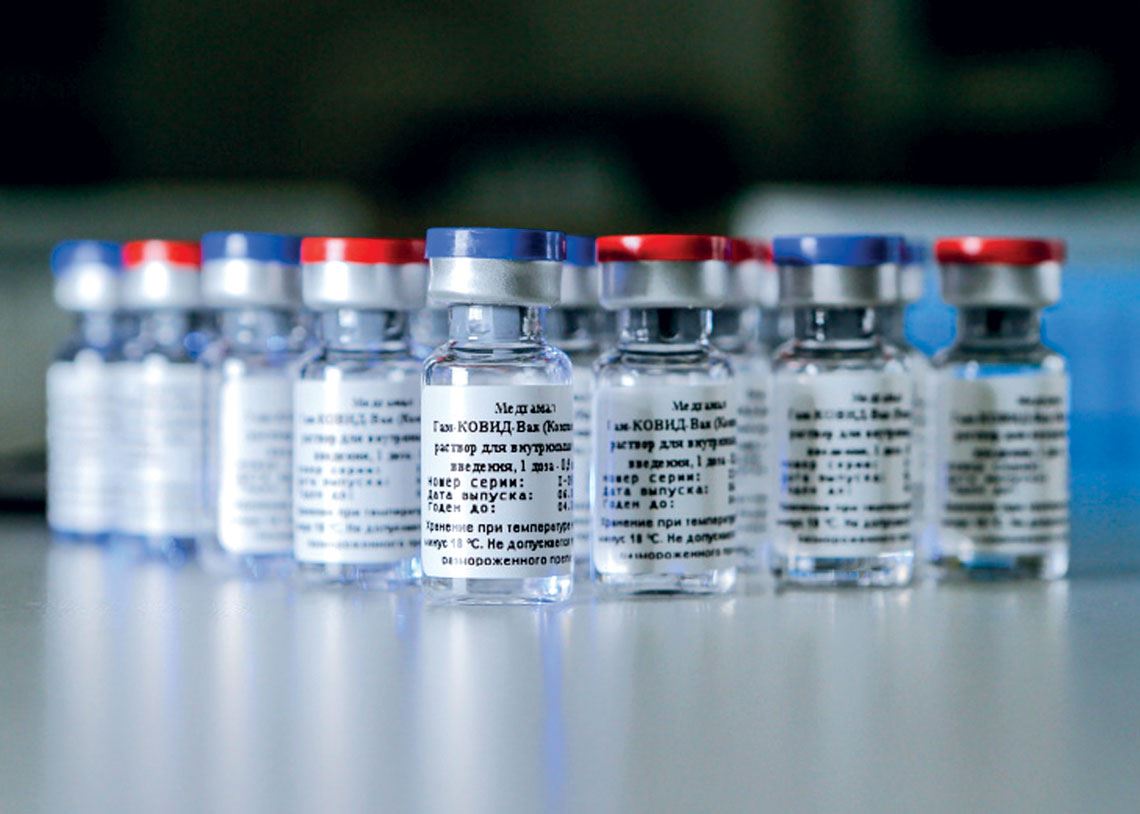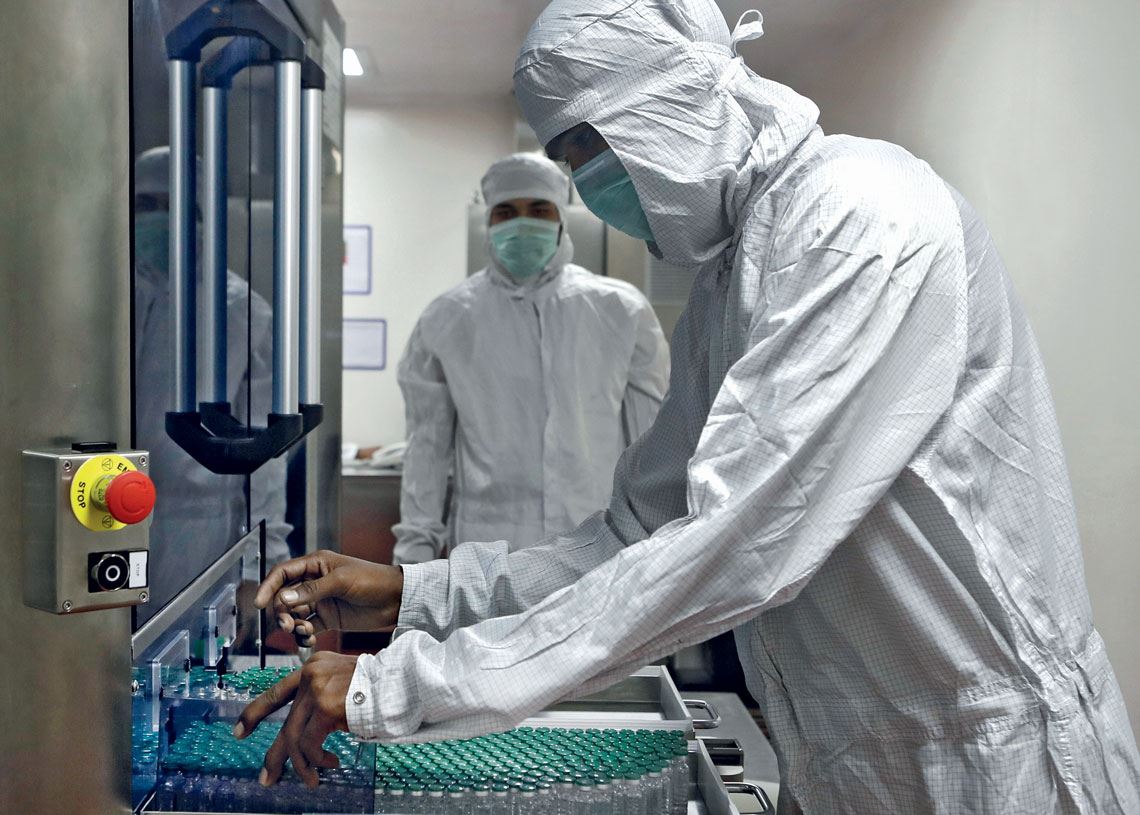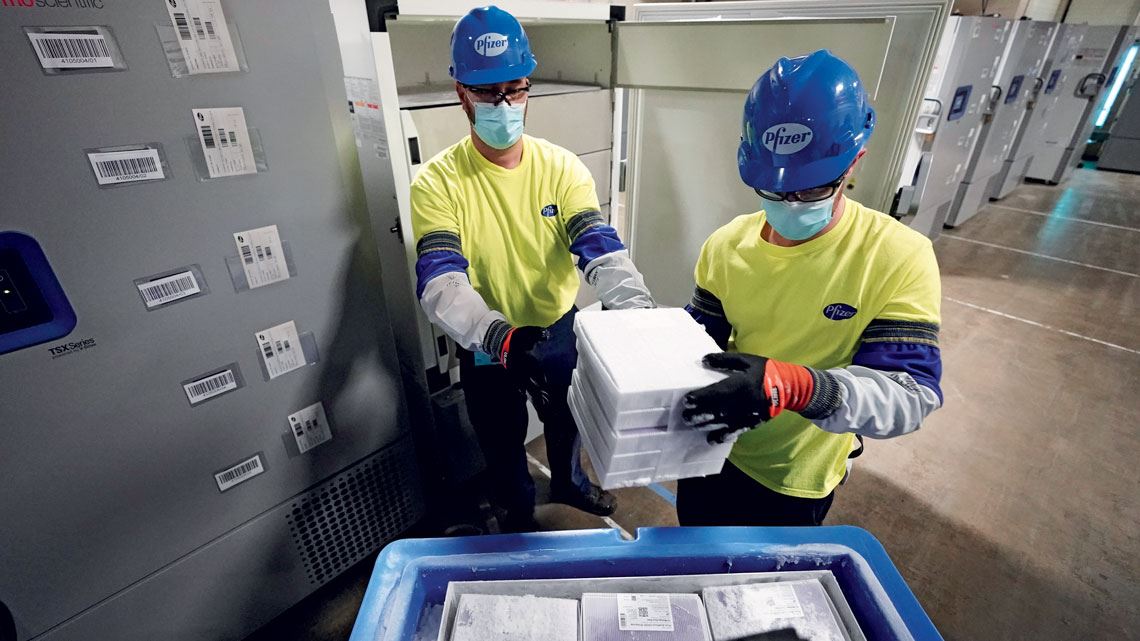The novel coronavirus pandemic affected more than 80 million people worldwide in 2020, killing 1.8 million. This year, humanity is hoping that new vaccines will help contain the virus and stop the spread of COVID-19, the disease it causes. To achieve this goal, vaccines need to be distributed to at least 5 billion people around the planet, an unprecedented logistical feat. The operation already has an estimated scale and timeframe: the aim is to administer 10 billion doses by the end of 2022, according to the white paper “Delivering Pandemic Resilience,” published by German logistics company DHL in partnership with American management consultancy McKinsey.
This is the effort needed to immunize 65% of the global population of 7.8 billion individuals, remembering that the majority of approved or nearly approved vaccine candidates require two doses per person. The percentage represents how many people need to be vaccinated to achieve herd immunity, where the spread of the virus is contained because so few people are susceptible to infection. DHL projects that 15,000 flights carrying 15 million cooled boxes of vaccines will be needed to reach this target.
The challenge of a global mass vaccination campaign is to safely, quickly, and fairly produce, transport, store, and administer the vaccines. On top of this, priority groups chosen to receive the first doses need to be defined, while avoiding undue advantages for richer individuals and countries and minimizing waste.
Among the more than 200 vaccine candidates under development, five were at an advanced stage in the second half of December: BNT162b2, produced by American pharmaceutical company Pfizer and German biotechnology company BioNTech; mRNA-1273, made by American biotechnology company Moderna; Sputnik V, from Russia’s Gamaleya laboratory; AZD1222, created by British company AstraZeneca and the University of Oxford, which has a partnership in Brazil with the Oswaldo Cruz Foundation (FIOCRUZ); and CoronaVac, developed by Sinovac, a Chinese biotechnology company that has a cooperation agreement with the Butantan Institute, in São Paulo.
The AstraZeneca, Pfizer, and Sinovac vaccines are, at the time of writing on December 23, the only purchasing options available to the Brazilian Ministry of Health. An agreement has already been signed with AstraZeneca for the delivery of 100.5 million doses in the first half of 2021. The contract includes a transfer of technology to FIOCRUZ to allow it to produce the vaccine at its Institute of Technology in Immunobiology (Bio-Manguinhos). Negotiations are ongoing with Pfizer and Sinovac for the acquisition of 70 million and 46 million formulations respectively—the Chinese vaccine supply could later be increased by a further 100 million units.
The federal government also expects to receive 42.5 million doses from Covax Facility, a program created by the World Health Organization (WHO) to provide vaccines to 184 countries with low purchasing power. In total, the Brazilian Ministry of Health expects to receive more than 300 million COVID-19 vaccine doses in 2021. The agency, however, has not yet established a vaccination schedule or a date to start the campaign in the country.
In São Paulo, the Butantan Institute started bottling the first batches of CoronaVac in December, using raw material from China. The São Paulo government’s intention is to begin immunization in the state on January 25. At the time of writing, the results of CoronaVac’s phase 3 clinical trials have not yet been released, and authorization from the Brazilian Health Regulatory Agency (ANVISA) is yet to be granted (see report).
The governments of many countries prepared for the immunization drive in advance, signing purchase agreements with pharmaceutical companies in the early stages of vaccine development in the first half of 2020. The USA, for example, has guaranteed 100 million doses of Moderna’s vaccine and another 100 million of Pfizer’s. As soon as the Pfizer vaccine was approved in the country in mid-December, immunization began. The UK signed contracts for 40 million doses and also started vaccinating its population in late 2020 after the Pfizer vaccine was approved by its regulatory agency. Russia began immunizing its population in the first week of December—even though phase 3 trials of its vaccine, called Sputnik V, had not been completed.

Gamaleya National Center / Russian Direct Investment Fund
Sputnik V: the Russian vaccine is already being used in MoscowGamaleya National Center / Russian Direct Investment FundOf the group of vaccines in humanity’s arsenal against COVID-19, the most complex to distribute is Pfizer’s, which needs to be transported and stored at -70 degrees Celsius (ºC). Most of the Brazilian logistics structure, which includes warehouses, refrigerated trucks, and vaccination posts with refrigerators and freezers, is not equipped for a product that requires such conditions. The cold chain for the distribution of vaccines in Brazil can operate at between 2°C and 8°C (for products that need to be kept refrigerated) or between -15°C and -25°C (for those that need to be kept frozen).
In anticipation of the difficulties many countries would face adapting their cold chains, Pfizer developed a means of packaging its vaccine in dry ice, so that it remains at -70°C for up to 30 days. According to the company, BNT162b2 can also be stored in standard refrigerators for up to five days, at temperatures of 2–8°C, without reducing its effectiveness.
Experts say it is possible to adapt part of the Brazilian cold chain to make storage and distribution of the vaccine viable. Brazil has tens of thousands of Basic Health Units (UBS) that serve as vaccination posts, according to mechanical engineer Ariel Gandelman, a refrigeration specialist and a representative of the National Council for Climatization and Refrigeration (CNCR).
“These vaccination posts are spread over a territory of continental proportions with a predominantly hot and humid tropical climate,” he says. “Of all countries, we face the greatest technical challenge in maintaining low temperatures along such an extensive supply chain.” Gandelman says the country has the know-how and an industry capable of making the adaptations needed to enable storage and distribution of ultra-cold vaccines like Pfizer’s. “We can increase the cooling power or improve the thermal insulation capacity of our storage centers and transportation.” How long this would take to implement in a country the size of Brazil, however, remains unknown.
To facilitate the use of Pfizer vaccines in the country, the Brazilian Academy of Sciences (ABC) suggested using special freezers at the research laboratories of Brazilian universities. “Although this equipment is in use, it is always possible to free up some space,” says physicist Márcia Bernardes Barbosa, the director of ABC and a professor at the Institute of Physics (IF) of the Federal University of Rio Grande do Sul (UFRGS).
Barbosa’s research group is exploring another alternative for transporting the Pfizer vaccine. “Currently, dry ice is used, but if we were to receive a large number of vaccines, national dry ice production wouldn’t be able to keep up. We are exploring the possibility of using liquid nitrogen for transport. We hope to have a positive result by the end of January,” says the researcher.
According to a document from the National Immunization Program, the Brazilian cold chain is prepared to receive any of the other vaccines in the final phase of testing, including Moderna’s mRNA-1273, whose ideal transportation temperature is around -20°C and which can be stored in a standard refrigerator for 30 days.
Most of the vaccines on the national immunization schedule, such as those for influenza, tuberculosis (BCG), and diphtheria, whooping cough, and tetanus (DPT), have to be kept in a refrigerator at 2–8°C. The vaccines for yellow fever and polio—the famous drops taken by mouth—require transportation and storage at between -15°C and -25°C.
As well as the vaccines themselves, health officials need to provide syringes and needles, both essential for immunization. In December, the Ministry of Health issued a public call for the supply of 330 million vaccine administration kits, to be delivered in full by the end of 2021. By March, another 40 million are expected to be sent to the country by the Pan American Health Organization (PAHO), the WHO’s arm for the Americas. The São Paulo state government also sought to procure 100 million syringes and needles via reverse auctions with suppliers.

Francis Mascarenhas / Reuters / Fotoarena
Officials at the Serum Institute of India inspect vials containing the vaccine made by British company AstraZenecaFrancis Mascarenhas / Reuters / FotoarenaAnother major hurdle is how to identify who has been vaccinated. Keeping track of who has had the vaccine is essential to ensure that both doses are given and to measure vaccine coverage and effectiveness. Epidemiologist Carolina Coutinho, a PhD researcher at the São Paulo School of Business Administration (EAESP) at the Getulio Vargas Foundation (FGV), says that the electronic medical records (PEC) kept by e-SUS Primary Health Care System (APS)—which contains all of a patient’s clinical information—could be used to identify and monitor participants in the vaccination campaign in municipalities where the system is in use.
According to Coutinho, although Brazil has the expertise and infrastructure needed to receive and administer SARS-CoV-2 vaccines, the logistical challenges are compounded by difficulties in planning and communicating the preparations for when the vaccines arrive in the country.
“In the 1980s, during the campaigns against polio, SUS [the Brazilian Public Healthcare System] managed to vaccinate 15 million children in one day,” recalls epidemiologist Carla Domingues, who ran the National Immunization Program (PNI) between 2011 and 2019. The government has already announced that it will not be able to vaccinate the entire Brazilian population in 2021. The PNI serves 212 million people and is one of the largest vaccination programs in the world.
Pesquisa FAPESP requested details of the vaccination campaign from the Ministry of Health, but received no reply. The absence of a national vaccination strategy, as well as the lack of assertiveness in decision-making, according to experts, have compromised logistical preparations. “If Brazil wants to vaccinate as many people as possible in the shortest amount of time, it will have to buy vaccines from more than one manufacturer. This poses another challenge. Using multiple different vaccines with different storage requirements and application processes is much more work for the public health network,” says Domingues.
Any delays by the Ministry of Health in starting the immunization campaign could lead to a situation where some states, such as São Paulo, begin vaccinating their populations before the federal government, which would be unprecedented in the country. “People are used to the Ministry of Health purchasing vaccines and distributing them nationally. It could be the first time that states purchase vaccines with their own money—which is actually covered in the PNI regulations,” says Domingues. “However, if the coordination between state governments and the Ministry of Health is not good enough, this strategy could become a problem, with people who live in one municipality able to seek the vaccine in another, hindering the campaign itself and making it difficult to assess its effectiveness. It is crucial that the Ministry of Health takes the lead and coordinates the national strategy.”
While coordination between the federal and state governments is essential, it is communication between these authorities and the public, who represent the end of the logistics chain, that is key to the success or failure of the vaccination campaign. “Communication is a major challenge. Low- and middle-income countries do not usually face problems with public confidence in vaccines, so take-up is usually high, between 95% and 98%,” says Elize Massard da Fonseca, a specialist in public health and a professor at FGV. “But misinformation, often spread for political purposes, creates confusion. I have heard, for example, people saying that they are not going to get the ‘Chinese vaccine’, which is worrying.”
Fonseca emphasizes that proper communication should reassure the public about vaccine safety. “It is important to make it clear that ANVISA would not approve a product that isn’t safe,” she says. Convincing Brazilians to attend vaccination centers is another challenge.
Information is also an important part of the logistics chain, as explained by Prashant Yadav, a specialist in healthcare supply chains at Harvard Medical School in the USA. “Information flows are critical in managing vaccine distribution. Data on vaccine location—where they were delivered, who has sent them back, etc.—need to be collected regularly in order to adjust supply according to demand,” said Yadav during a webinar in December organized by FAPESP. “There are chances that lots of things will go wrong and we will not be able to vaccinate the priority groups if we do not have good information about each step of the process.”
Republish

